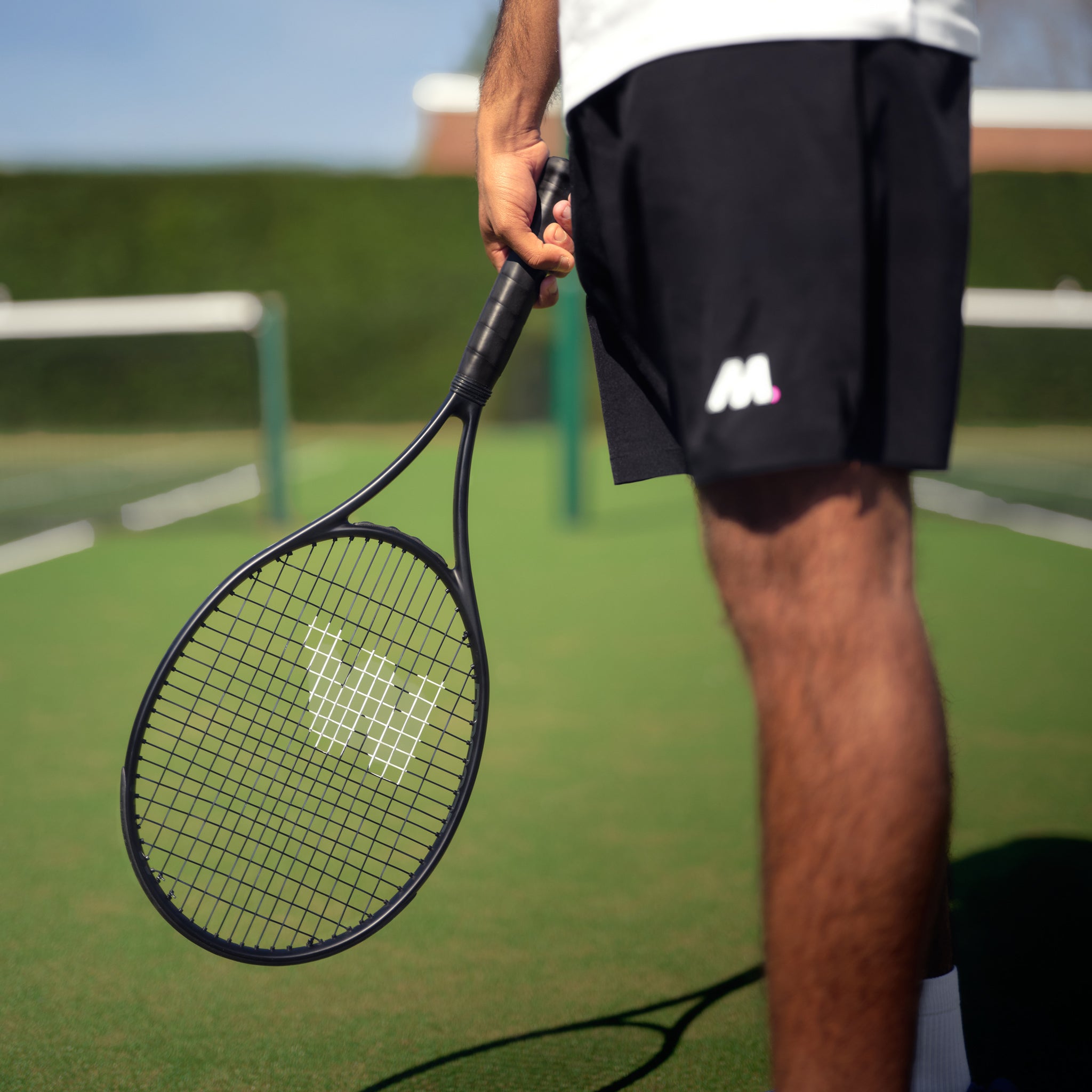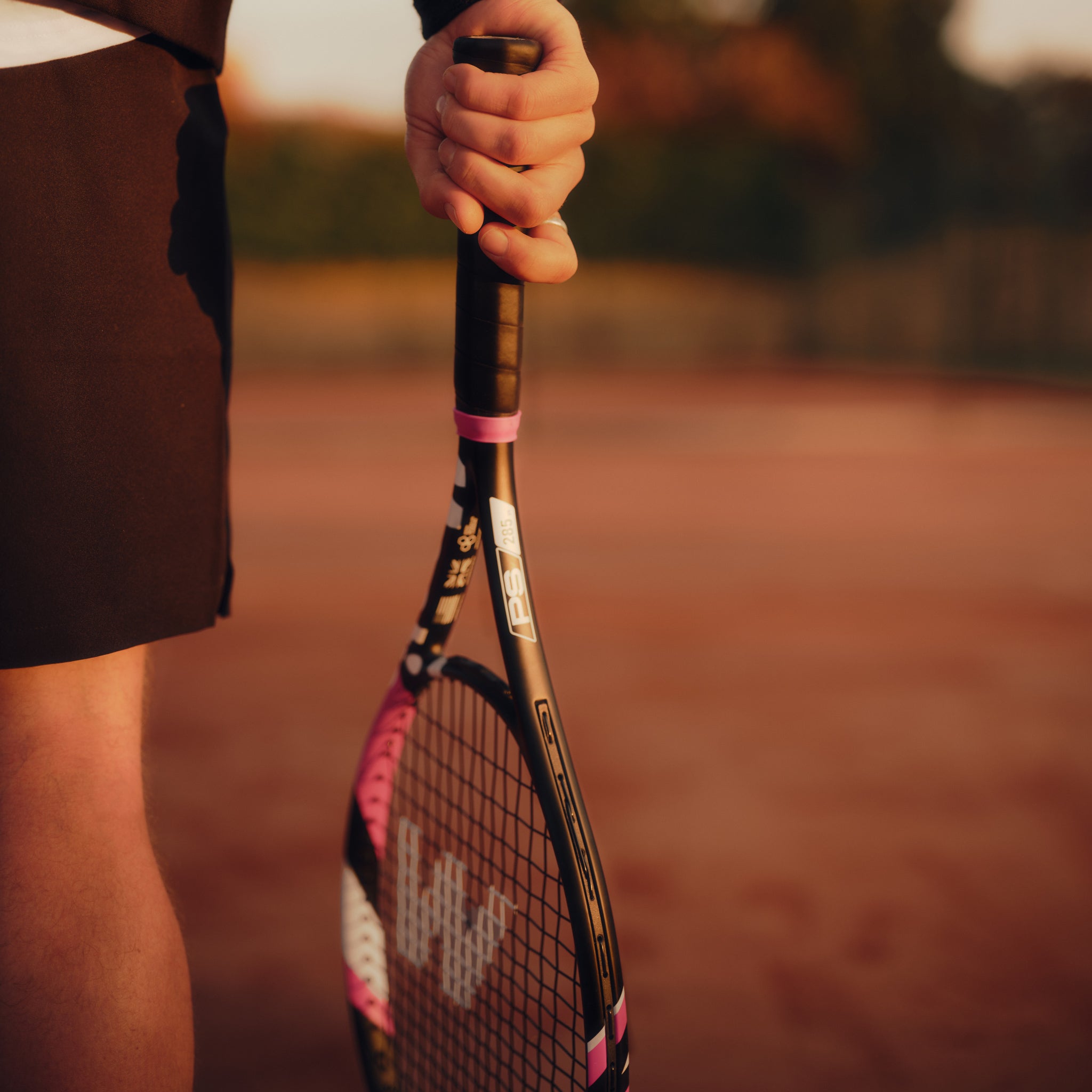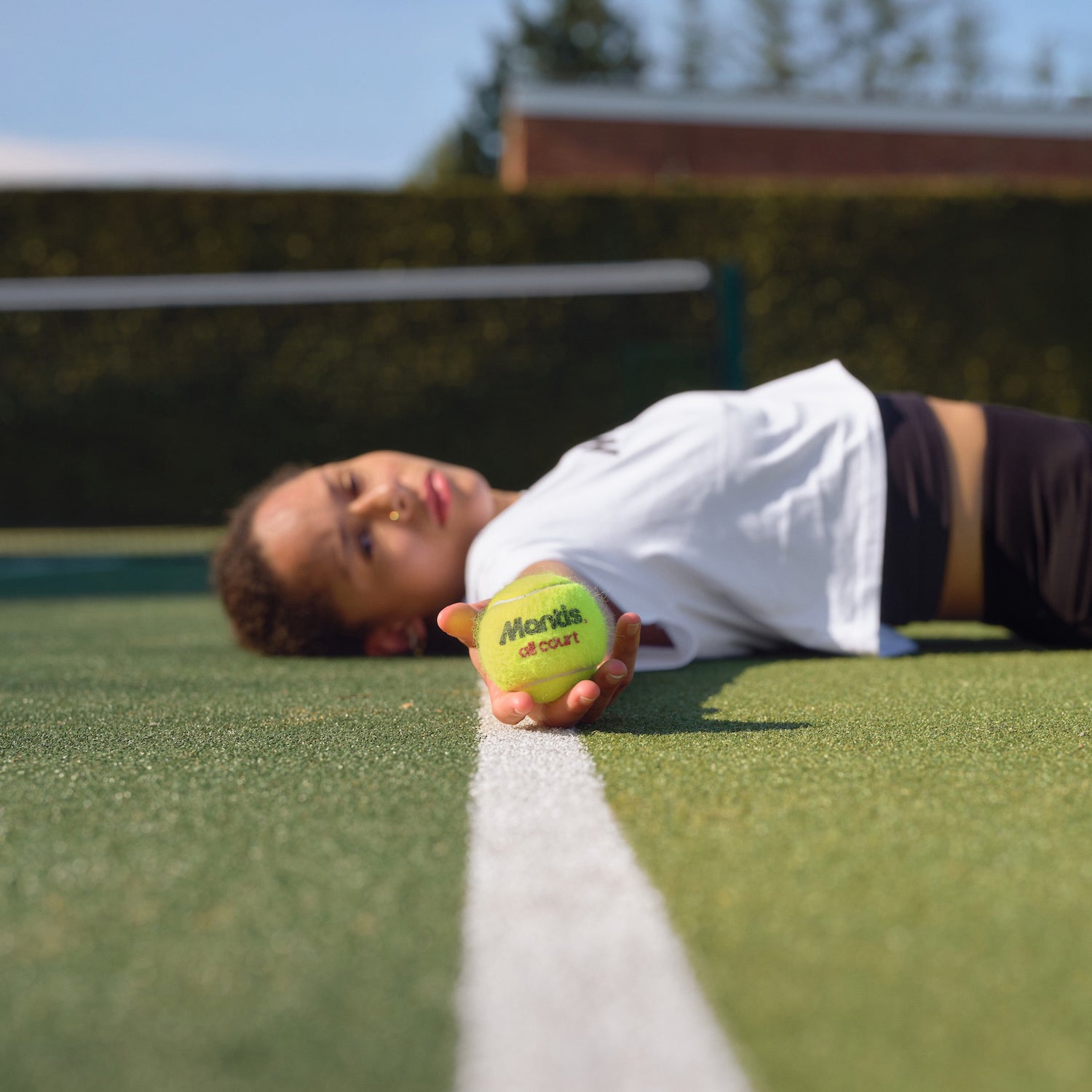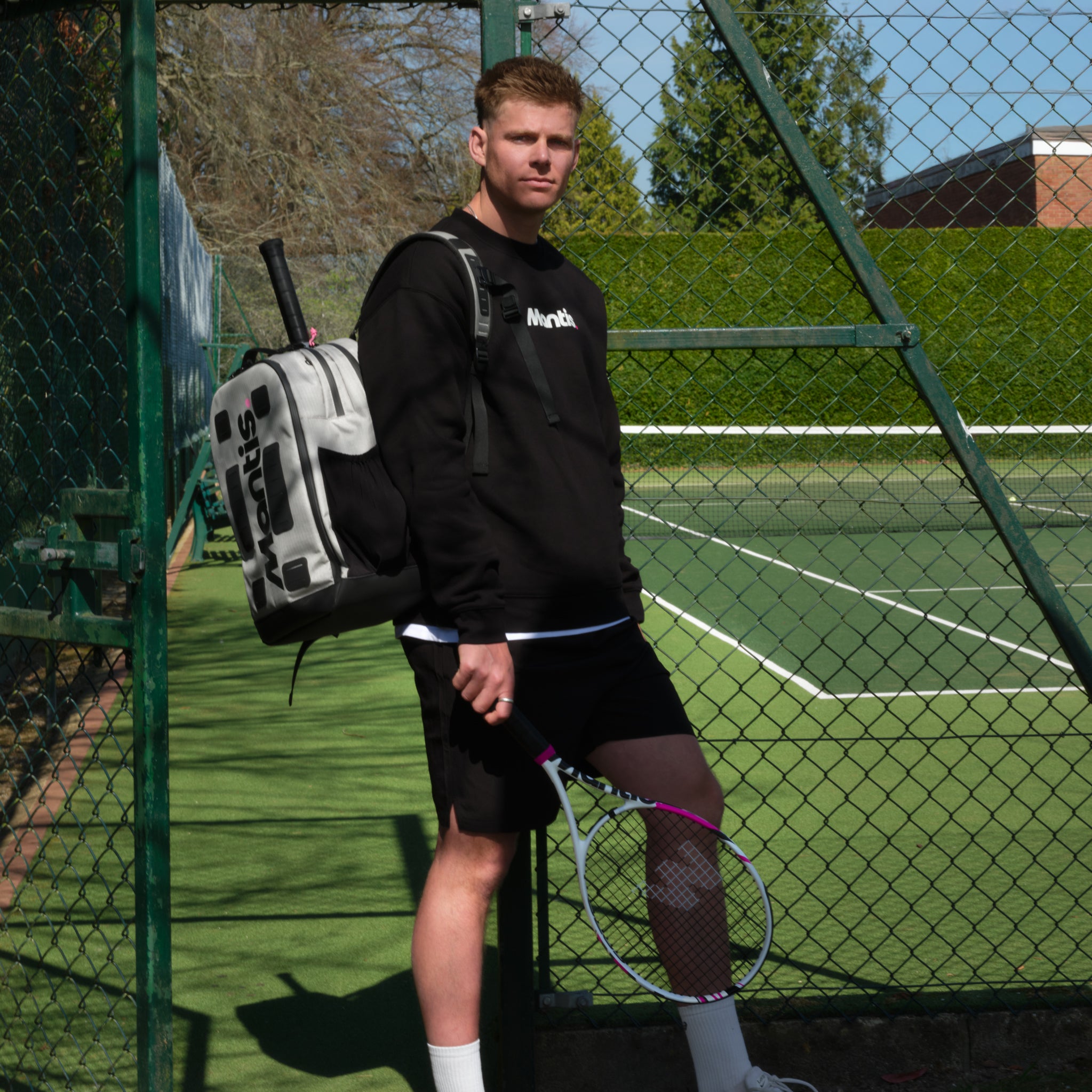
Picking the right equipment is your first volley in winning the match, and knowing how to select a tennis racquet is the key to it all. At Mantis, we’ve seen first-hand how the perfect frame can completely change a player's game and boost their confidence. It’s why our range of Mantis tennis racquets is engineered for performance.
Let's cut through the technical jargon and get straight to what matters.
Select a Tennis Racquet That's Right For Your Game
We're going to translate specs like head size, weight, and balance into practical advice you can actually use on the court. Forget the confusion; we'll break down how each element affects your power, control, and overall comfort.
By the end of this, you’ll be able to choose a racquet that feels less like a piece of equipment and more like an extension of your arm—one that’s perfectly matched to your playing style.
A Growing Market Means More Options
It's a great time to be a tennis player. The racquet market in the UK is seeing steady growth, which is brilliant news for all of us. Projections show sales volume growing at around 2.5% each year between 2024 and 2035.
What does that mean for you? It means manufacturers are constantly innovating, pushing technology forward and giving us better choices than ever before.
Your racquet is your most important piece of equipment. Taking the time to understand the key factors ensures you invest in a frame that complements your strengths and helps develop your weaknesses.
A well-chosen racquet does more than just hit the ball. It can:
- Boost Power: Helping you hit deeper, more penetrating shots with less effort.
- Improve Control: Giving you the confidence to aim for the lines with pinpoint precision.
- Enhance Comfort: Reducing the strain on your arm and helping to prevent common injuries like tennis elbow.
Decoding Head Size and Weight for Power and Control
Think of a racquet's head size and weight as its core personality. These two specs are the biggest factors in how the frame will feel and perform, directly influencing your power potential and your ability to control the ball. Getting this combination right is probably the most important step in finding a racquet that feels like a natural extension of your arm.
The head size, measured in square inches, defines the hitting area. It's all about the "sweet spot" – that prime area on the string bed that gives you the cleanest, most powerful response. A bigger sweet spot is much more forgiving when you don't hit the ball perfectly in the centre, which is a lifesaver for players still developing their timing. For a more detailed look, Mantis has a complete guide on choosing your tennis racquet head size.
Finding the Right Dimensions
Generally, racquet heads fall into one of three main camps, each with its own distinct advantages:
- Oversize (105+ sq. in.): These are the powerhouses. An oversize head provides a massive sweet spot and generates a lot of pop with very little effort. It’s an ideal choice for beginners or players who have a shorter, more compact swing.
- Mid-Plus (98-104 sq. in.): This is the sweet spot for a huge number of players, from competitive intermediates to seasoned club champions. You get a fantastic blend of power and control, with enough forgiveness to keep you out of trouble but enough precision for when you want to hit your targets.
- Midsize (Under 98 sq. in.): This is territory for advanced players and pros. A smaller head size offers unparalleled control and a connected-to-the-ball feel. The catch? You need to generate your own power and find the sweet spot consistently.
To help you visualise how these specs come together, take a look at the key features labelled on a racquet.
This highlights the classic trade-off: a larger head provides more power, while a smaller one gives you more precision. It's a fundamental choice every player makes.
To make this a bit clearer, here’s a simple table that matches head sizes with typical player levels.
Racquet Head Size and Player Level
| Head Size (sq. in.) | Player Level | Primary Benefit |
|---|---|---|
| 105+ | Beginner | Forgiveness and Power |
| 98-104 | Intermediate/Advanced | Blend of Power/Control |
| Under 98 | Advanced/Professional | Precision and Feel |
As you can see, your current skill level is a great starting point for figuring out which head size will best support your game.
Weighing Your Options
Next up is the static weight. A heavier racquet (think over 310g) provides more stability on impact. It plows through the ball, absorbing shock from your opponent’s heavy shots and adding serious mass to your own. The downside is that you need the strength and technique to swing it effectively for a full match.
On the other hand, a lighter racquet (under 285g) is incredibly easy to swing. This manoeuvrability helps you generate racquet head speed for spin and power, and allows you to react faster at the net. The compromise is that it can feel less stable against a big hitter.
The perfect weight is subjective. It’s about finding a racquet that feels substantial enough to be stable, but light enough for you to swing freely without tiring.
Getting to Grips with Racquet Balance and Swingweight
Beyond the simple static weight, the balance of a racquet is where its true personality shines through on the court. It's a detail many players accidentally skip over when they're trying to figure out how to select a tennis racquet, but here at Mantis, we know it's what truly dictates how a frame feels in motion.
Getting this right is crucial for finding a racquet that works with your natural swing, not against it.
Balance is all about how the weight is spread out from handle to tip. This distribution has a massive impact on both manoeuvrability and stability, shaping the feel of every single shot you hit. It's all measured from its balance point, which tells you if the racquet is head-light, head-heavy, or evenly balanced.
The Feel of Different Balances
Each balance type brings something different to the table, suiting various playing styles. Making the right choice here can genuinely transform your game.
-
Head-Light: With more of its mass shifted towards the handle, this setup feels incredibly quick through the air. It’s a favourite for advanced players and aggressive net-rushers who need lightning-fast reactions for crisp volleys and powerful serves.
-
Head-Heavy: Here, the weight is packed into the head of the racquet. This design puts more oomph behind the ball on contact, helping you generate some serious power without having to force it. You'll often find this in the hands of baseliners who love to hit deep, heavy groundstrokes.
-
Even Balance: As the name suggests, this is the perfect middle ground. It offers a fantastic blend of power and control, making it a versatile choice for all-court players who need a racquet that performs reliably from anywhere on the court.
A racquet’s balance isn't just a number on a spec sheet; it's the key to unlocking a feel that truly syncs with your game. The right balance makes a racquet feel like an extension of your arm, while the wrong one can feel clumsy and completely out of sorts.
Understanding Swingweight
This naturally leads us to swingweight, a critical metric that's often misunderstood. While static weight is just how heavy the racquet feels when you pick it up, swingweight tells you how heavy it feels when you swing it.
A higher swingweight means more power and stability. The racquet simply ploughs through the ball more effectively on impact.
On the other hand, a lower swingweight makes the frame easier and faster to swing, which is perfect for generating wicked spin. Think of it like a hammer: a sledgehammer (high swingweight) delivers immense force, while a tack hammer (low swingweight) is all about speed and precision. The goal is to find a swingweight that matches your physical strength and swing style.
String Patterns: Your Engine for Spin and Feel
Think of the strings in your racquet as the engine room. The way they're arranged—the string pattern—has a massive impact on how the ball comes off your frame, dictating everything from spin potential to outright control. It’s a detail many players overlook, but getting it right can truly elevate your game.
Let’s break down the two main philosophies here: open and dense patterns. Each has a very different personality, and one will almost certainly suit your style of play more than the other.
Open String Patterns: The Spin Machine
If you're a modern, aggressive player who loves to rip the ball with heavy topspin, you'll want to look at an open string pattern. The most common one you'll see is 16x19 (that’s 16 main strings running top to bottom, and 19 cross strings going side to side).
What makes it so spin-friendly? The wider spacing between the strings. This gives them more room to move, bite into the felt of the ball, and then snap back into place on impact. It’s this "snapback" effect that generates that vicious, dipping topspin. If you live on the baseline and want your shots to kick up high and trouble your opponent, an open pattern is your ticket.
Dense String Patterns: The Scalpel
On the flip side, we have dense string patterns, with the classic example being 18x20. Here, the strings are packed much more closely together. This significantly reduces how much they can move when you strike the ball.
The result? A much firmer, more connected feel. This setup is all about control and precision. Players who hit flatter shots and rely on placing the ball with pinpoint accuracy often swear by a dense pattern. It gives you a wonderfully predictable response, which is exactly what you need when you're aiming for a sliver of the line. It's less about raw power and more about surgical placement.
At the end of the day, the string pattern is a trade-off. An open pattern gives you a higher, looping, spin-loaded shot. A dense pattern delivers a lower, more direct, and controlled ball flight.
Here in the UK, the tennis equipment market is really booming, and it's not just the pros driving it. We're seeing a huge rise in recreational players getting serious about their gear, which has led to fantastic innovations in racquet design for all levels. If you're interested in the market trends, Future Market Insights has some great analysis on this growth.
Getting a Handle on the Right Grip Size
Of all the things to consider when choosing a racquet, getting the grip size right is perhaps the most crucial. It’s something we’re passionate about at Mantis because a proper fit is the foundation for solid technique, shot control, and, most importantly, avoiding nasty injuries like tennis elbow.
Think about it: a grip that’s too small makes you clench the handle for dear life. Your muscles get tired quickly, and the racquet feels unstable when you hit the ball. On the other hand, a grip that’s too chunky restricts how your wrist can move, robbing you of racquet head speed and making it a real chore to hit shots with any kind of feel. Our range of Mantis tennis grips and overgrips is designed to help you nail that perfect feel.
Two Easy Ways to Find Your Fit
You don't need a high-tech lab to figure this out. There are a couple of tried-and-tested methods you can do right now to get your measurement.
-
The Finger Test: This is the classic on-court check. Hold the racquet in your hitting hand with a natural Eastern forehand grip—as if you're shaking hands with it. Now, try to slide the index finger of your other hand into the gap between your palm and your fingertips. It should fit snugly. If there's a big gap, the grip is too large. If you can't squeeze your finger in at all, it's too small. Simple as that.
-
The Ruler Test: For a more precise measurement, grab a ruler. Open your hitting hand flat, with your fingers held together. Measure from the middle crease in your palm right up to the tip of your ring finger. That length in inches is your grip size. For example, a measurement of 4 3/8 inches means you need a UK grip size 3.
An incorrect grip size is one of the quickest ways to develop bad habits and potential injuries. Taking a few minutes to measure correctly ensures your equipment supports your technique rather than hindering it.
And don't forget the power of an overgrip! They're brilliant for making tiny adjustments. A single overgrip will typically add about 1/16 of an inch to the handle's circumference, which can be just enough to turn a good grip into the perfect one.
Putting It All Together: Your Racquet Checklist
Alright, we've covered the theory. Now it's time to connect the dots and figure out how to pick a tennis racquet that genuinely clicks with your game. Here at Mantis, we're firm believers that the single most important part of this whole process is getting out on court and actually hitting with the racquet.
You can read our full guide on how to choose a tennis racket for a deeper dive, but nothing beats firsthand experience.
The UK's lawn tennis racquet market is a big deal, valued at around $60.827 million back in 2022. That competition is great news for players like us, as it drives innovation with materials like graphite and carbon fibre composites that completely change how a frame feels and performs.
Your On-Court Demo Plan
Before you even think about buying, you need to demo a racquet. A good frame should feel like it’s part of your arm, whether you're ripping a forehand or feathering a drop shot.
Here’s a simple hitlist for your demo session:
- Groundstrokes: Are your shots landing deep with good control? Check how it feels on both wings. Notice the difference between when you flatten a shot out versus when you load it up with topspin.
- Serves: Is power coming easily, or are you having to muscle it? Pay attention to the feel at contact and how smoothly the racquet cuts through the air. You shouldn't have to fight it.
- Volleys: Up at the net, does the frame feel stable on impact but still quick to get into position? You want something solid enough to punch volleys back, not something that gets pushed around.
- Returns: How does it stand up to a big server? Block a few fast serves back. The racquet should feel stable, absorbing the pace without twisting in your hand.
Demoing is non-negotiable. It’s the only way to translate numbers and specs into how a racquet actually feels and plays for you.
This is how you move past the marketing hype and make a smart choice based on what really works for your game on the court.
Your Top Racquet Questions, Answered
Over the years, we've helped countless players find their perfect match, and a few key questions always come up. Let's tackle some of the most common ones we hear on the court.
How Often Should I Get a New Racquet?
This is a big one. For serious, competitive players, we generally recommend getting a new frame every 2-3 years. It might seem surprising, but the constant stress of hitting causes the racquet's materials to soften and lose their punch over time. You might not notice it day-to-day, but that loss of power and crisp feel can make a real difference in a tight match.
What's the Deal with String Tension?
Ah, string tension—it’s a game-changer. Think of it as the engine of your racquet. Lowering the tension (making the strings looser) gives you a kind of trampoline effect, which means more free power. On the flip side, higher tension (tighter strings) gives you more control, which is great if you already generate plenty of your own pace and need to rein it in.
Do I Need Different Racquets for Clay and Hard Courts?
For most club and recreational players, the simple answer is no. It's far more important to find one primary racquet that truly complements your personal playing style, regardless of the surface. Focus on a frame that feels right for your game, not the court.








